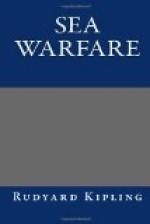The Trade has many stories, too, of watching patrols when a boat must see chance after chance go by under her nose and write—merely write—what she has seen. Naturally they do not appear in any accessible records. Nor, which is a pity, do the authorities release the records of glorious failures, when everything goes wrong; when torpedoes break surface and squatter like ducks; or arrive full square with a clang and burst of white water and—fail to explode; when the devil is in charge of all the motors, and clutches develop play that would scare a shore-going mechanic bald; when batteries begin to give off death instead of power, and atop of all, ice or wreckage of the strewn seas racks and wrenches the hull till the whole leaking bag of tricks limps home on six missing cylinders and one ditto propeller, plus the indomitable will of the red-eyed husky scarecrows in charge.
There might be worse things in this world for decent people to read than such records.
II
BUSINESS IN THE SEA OF MARMARA
This war is like an iceberg. We, the public, only see an eighth of it above water. The rest is out of sight and, as with the berg, one guesses its extent by great blocks that break off and shoot up to the surface from some underlying out-running spur a quarter of a mile away. So with this war sudden tales come to light which reveal unsuspected activities in unexpected quarters. One takes it for granted such things are always going on somewhere, but the actual emergence of the record is always astonishing.
Once upon a time, there were certain E type boats who worked the Sea of Marmara with thoroughness and humanity; for the two, in English hands, are compatible. The road to their hunting-grounds was strewn with peril, the waters they inhabited were full of eyes that gave them no rest, and what they lost or expended in wear and tear of the chase could not be made good till they had run the gauntlet to their base again. The full tale of their improvisations and “makee-does” will probably never come to light, though fragments can be picked up at intervals in the proper places as the men concerned come and go. The Admiralty gives only the bones, but those are not so dry, of the boat’s official story.
When E14, Commander E. Courtney-Boyle, went to her work in the Sea of Marmara, she, like her sister, “proceeded” on her gas-engine up the Dardanelles; and a gas-engine by night between steep cliffs has been described by the Lower-deck as a “full brass band in a railway cutting.” So a fort picked her up with a searchlight and missed her with artillery. She dived under the minefield that guarded the Straits, and when she rose at dawn in the narrowest part of the channel, which is about one mile and a half across, all the forts fired at her. The water, too, was thick with steamboat patrols, out of which E14 selected a Turkish gunboat and gave her a torpedo. She had just time to see the great column of water shoot as high as the gunboat’s mast when she had to dip again as “the men in a small steamboat were leaning over trying to catch hold of the top of my periscope.”




